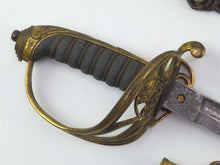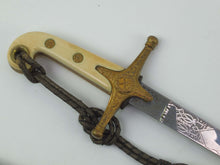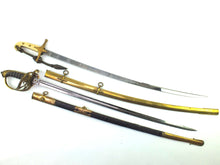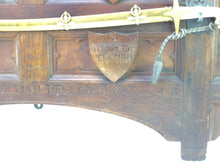
A Magnificent and Rare Carved Oak Sword Rack of Lieutenant General Sir William Bellairs. K C M G, C B. and Two Swords.
Missed out on this item? Click to view all current Antique Swords & Edged Weapons Free UK delivery on all items.
Carved oak sword rack comprising 8 panels, surmounted with elaborate personal coat of arms with scrolling foliage. With 8 carved shields for each of his campaigns with Alma, Inkerman, Sebastopol, The Redan, Kaffir War 1877-8, Zulu War 1879, Transval 1880-1, Defence of Pretoria. With carved panels of bay leaves to left hand and carved oak leaves and acorns to right hand, with patinated copper sword hooks.
With an 1822 Infantry Officers sword. 39” overall with 32 ½” fullered blade etched with crowned VR and scrolling foliage on both sides and ‘Henry Wilkinson Pall Mall London’. With gilt gothic hilt inset with crowned VR, stepped pommel and acanthus backstrap, with fish skin grip and gilt twisted wire. In its black leather and gilt brass scabbard, with two suspension rings and frog stud. Circa 1854.
In good condition with much original polish to sword, bottom half of the scabbard a little weak.
And A General Officers Mameluke sword. 38 ½” overall with 33” slender mameluke blade, finely etched with crowned VR, palm leaves, crossed swords and “E. Thirkle, maker, Soho London”. With gilt cross guard, silver bullion sword knot, contained in its gilt brass scabbard with two suspension rings. Very good condition, blade with all original polish. Circa 1900
Major-General Sir William was born on 28 August 1823, the youngest son of Sir William Bellairs, of Mulbarton, Norfolk, who had served with the 15th Hussars, in the Peninsula and at Waterloo. He entered the 49th Regiment as ensign on 8 May 1846, becoming captain in 1854. He served throughout the Crimean War, being one of the comparatively few combat officers who remained at the front for the duration of the war, and took part in the battles of Alma and Inkerman, and the siege and fall of Sebastopol. He was present at the repulse of the Russian sortie of 26 October 1854, the attack on the Quarries on 7 June 1855, and the two attacks on the Redan on 18 June and 28 September. He particularly distinguished himself at the Battle of Inkerman, and displayed a readiness of resource and clearness of perception in emergencies which would have done credit to a man of greater experience of war; especially on one occasion, when, after going into action in command of a wing of his regiment, he charged with the bayonet and utterly routed a strong Russian battalion advancing upon guns in position close to his small command of 183 men. His name was submitted for a brevet-majority but passed over on the ground that he had been promoted to captain only a few weeks before. From December 1854, until the close of the campaign he served on the staff of the 2nd Division, and, his distinguished conduct having brought to notice in despatches, he was promoted brevet-major, received the Crimean medal with three clasps, was appointed a Knight of the Legion of Honour, and was awarded the 5th Class of Medjidieh, together with the Turkish medal.
He subsequently served at intervals in various staff appointments in the West Indies, Ireland, Canada and Gibraltar, in the course of which he was promoted Lieutenant-Colonel in December, 1865, and Colonel in August, 1873. In May, 1877, he proceeded to the Cape of Good Hope as D.A. and Q.M.G., and in that capacity served throughout the Xhosa War of 1877-78, commanding the combined forces on the eastern frontier of the Cape Colony from December, 1877, to March, 1878. Having been repeatedly mentioned in despatches, he was nominated a C.B. as the reward of his services.
When in the following year, it was considered necessary to break the power of the Zulus, Colonel Bellairs was attached to the staffs first of Lord Chelmsford and then of Lord Wolseley, and commanded the laager for the protection of the column train during the engagement at Ulundi. He was repeatedly mentioned in despatches, was especially brought to the notice of the Secretary of State by Sir Bartle Frere, and was created K.C.M.G, also receiving a medal with clasp and being selected for a reward for distinguished service.
He next served in the dual capacity of military commander and civil administrator in the Colony of Natal, and when affairs in the Transvaal assumed a threatening aspect in like capacity in the latter territory—a work which gave full scope for the exercise of tact, combined with energy and soundness of judgment. In speaking of this phase in the career of Sir William Bellairs, it would be futile to revive the memory of strife and controversy, since subsequent events have brought about an adjustment which promises well for the future of the white races interested in the welfare of South Africa. Suffice it to recall the indefatigable energy and resource displayed by Sir William Bellairs in making provision for the defence of the various garrisons in the Transvaal, and his own direction of affairs during the three months' investment of Pretoria, for which he received the special thanks of the Commander-in-Chief.
He was promoted Major-General in September 1884, and, having retired from the active list with the hon. rank of Lieutenant-General in December 1887. He was appointed Colonel of the Sherwood Foresters in July 1902, and transferred to his old regiment, now the Royal Berks Regiment, on 9 June 1905.
Bellairs died 24 July 1913 at Clevedon, Somerset and was survived by his wife, Blanche St. John Bellairs (née Moschzisker) whom he married in 1867. He had previously been married to Emily Craven Gibbons (d. 1866). He was the father of five sons and two daughters, including Carlyon Bellairs

















